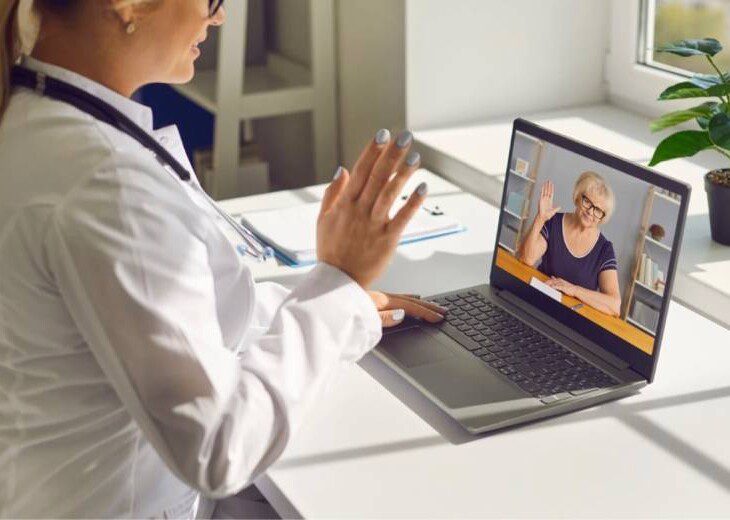Before March 2020, the way patients received healthcare from their doctors followed the expected series of steps: Schedule an in-person appointment; go into the doctor’s office to be seen; receive a diagnosis, advice, or a prescription; return home.
Almost overnight, the pandemic completely disrupted everything — especially the traditional delivery of healthcare. Stay-at-home orders designed to reduce the spread of COVID-19 meant patients couldn’t physically visit their doctors. Yet patients still needed healthcare services.
Enter the sudden popularity of a service called telehealth.
What is telehealth?
If you’ve ever gotten medical care via your smartphone, tablet, or desktop or laptop computer, you’ve received telehealth services. Typically, all you need for a telehealth appointment is one of those devices and an internet connection.
The Health Resources and Services Administration defines telehealth as “the use of electronic information and telecommunication technologies to support long-distance clinical healthcare, patient and professional health-related education, public health and health administration.”
In short, telehealth is getting services from your doctor, delivered to you remotely instead of in the doctor’s office.
Telehealth could be delivered through one of four ways:
- Live video conferencing through technology you use from your home during a live two-way video-based conference between you and your healthcare provider
- A nurse or other healthcare professional providing telehealth from a mobile van, such as a mobile mammography unit in rural or underserved areas
- Remote Patient Monitoring, which is the collection of health data from a patient or resident in one location that’s electronically sent to a healthcare professional for monitoring and review
- Asynchronous video, the electronic delivery of a patient’s documented health history outside of real time, used by a healthcare provider. Asynchronous video is often used in areas where providers are consulting with a specialist in another location; this type of telehealth also helps bring healthcare to areas where certain medical specialties are sparse.
Many people use telehealth and telemedicine interchangeably, but they’re actually different. While telemedicine refers specifically to remote clinical services, telehealth can refer to remote non-clinical services, such as provider training, administrative meetings, and continuing medical education, in addition to clinical services.
What are some common telehealth services?
You might be surprised to learn about the variety of specialized care available through telehealth. Telehealth is especially helpful in monitoring and improving ongoing health issues, such as medication changes or chronic health conditions.
Some examples of services you might receive include:
- Mental health treatment, including online therapy, counseling, and medication management
- Treatment for recurring conditions, such as urinary tract infections or migraines
- Care for skin conditions
- Lab test or x-ray results
- Prescription management
- Post-surgical follow-up
- Physical and occupational therapies
- Urgent care issues like stomach issues, colds, and coughs
- Remote monitoring services to help track health goals and manage chronic conditions like high cholesterol, high blood pressure, and diabetes
Your healthcare provider will usually decide whether telehealth is right for your health needs.
What is a telehealth appointment like?
If you’ve only ever received your healthcare by physically going to a doctor’s office, you might be wondering just how telehealth appointments work. You might be envisioning some kind of space-age experience.
The reality is a telehealth visit is very similar to an in-person visit, except you and the healthcare provider are in different places. Not being in person can be a bit disorienting for some patients, who aren’t used to talking to their doctor or nurse practitioner on a screen. Many people simply aren’t comfortable with or familiar with the technology required for a telehealth visit.
If that’s you, there are a number of things you can do to help your telehealth visit go smoothly:
Tell your healthcare provider if you need certain accommodations, such as a translator or closed captioning.
Check your email for instructions, which may include instructions on how to log on and use related technology.
Test your technology before your visit and tell a member of your healthcare team if you need them to send you a test link before your visit to identify any issues.
Write down important information before the visit, including your current medications and doses, as well as any symptoms, questions, or concerns you want to talk about. Keep paper and a pen handy to take notes, too.
How can I schedule a telehealth appointment?
Typically, it’s as easy as asking your healthcare provider if they can conduct your visit through telehealth rather than having you come into their office.
In fact, telehealth has become so common that you may be able to find a healthcare provider group online that offers appointment times 24 hours a day, seven days a week. Convenience is possibly one of telehealth’s biggest benefits, but it’s far from being its only advantage.
What are the advantages of telehealth?
We mentioned that in some cases, you can get an appointment based on your schedule instead of your doctor’s office hours. But what if you move to another city or state, away from your long-standing healthcare team who knows you and your health needs?
With telehealth, you don’t necessarily have to switch doctors. Instead, you may be able to keep your team through telehealth visits. This may be a big benefit if you’re an older adult who no longer drives long distances or whose caregivers are your adult children or spouse. Telehealth visits can help reduce some of the burden on them.
Two final advantages of telehealth: You can actually save both time and money. You can save time because you’re not driving to appointments and waiting in waiting rooms, and you can save money because telehealth visits are sometimes billed at a lower cost than an in-person visit — and are almost always covered by your insurance.
___________________________________________________________________________________
You might be wondering what telehealth and senior living have in common. The truth is, when it’s a senior living community like The Waterford, there’s quite a bit of common ground. We always make your health and well-being our top priority — and we believe in making good health and wellness work for you.
If you’re looking for a senior living destination that makes your health a priority, simply call us at 1-888-335-1678, or visit our website to learn more about us.


